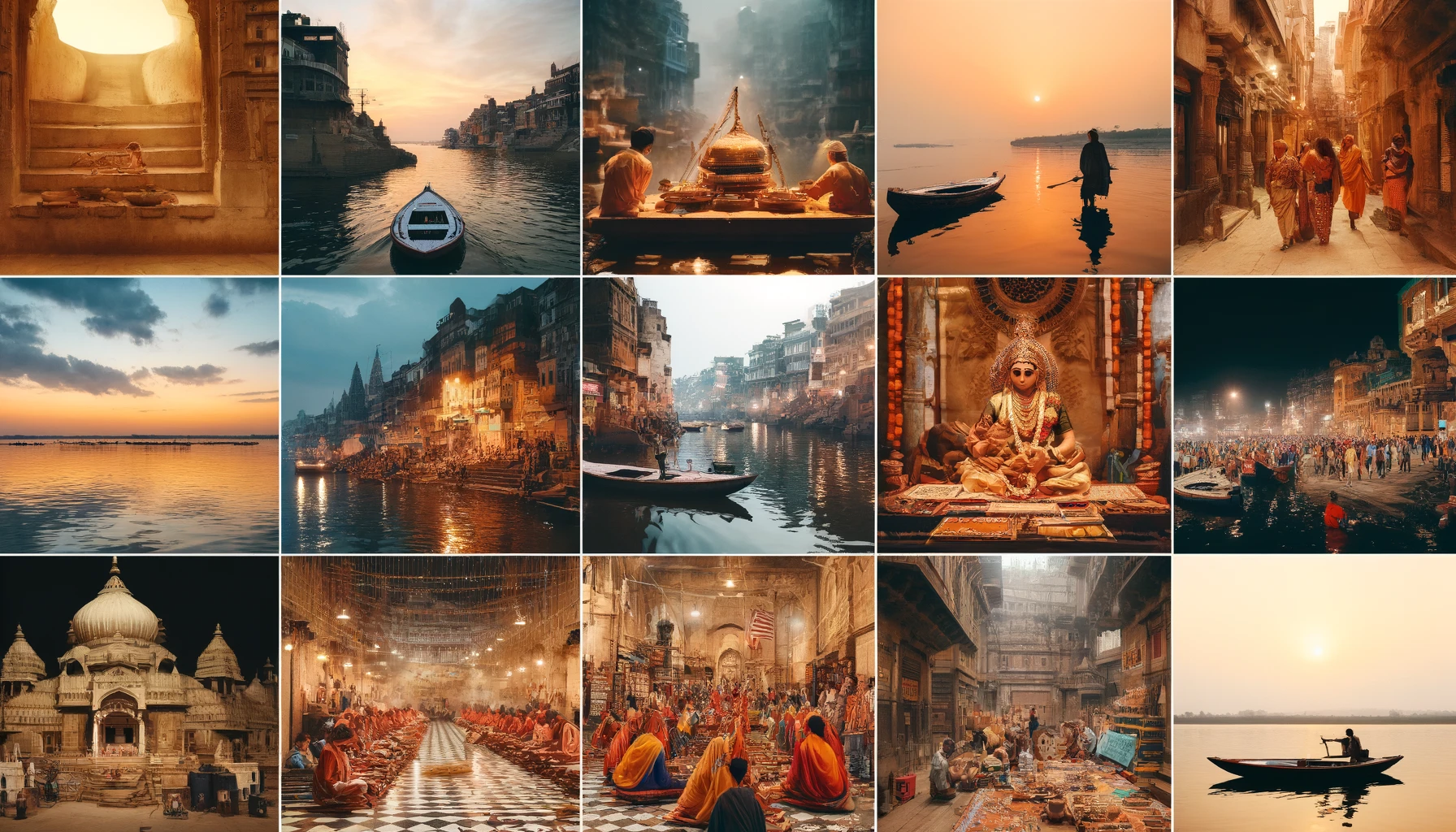Upgrade & Secure Your Future with DevOps, SRE, DevSecOps, MLOps!
We spend hours scrolling social media and waste money on things we forget, but won’t spend 30 minutes a day earning certifications that can change our lives.
Master in DevOps, SRE, DevSecOps & MLOps by DevOps School!
Learn from Guru Rajesh Kumar and double your salary in just one year.
Introduction
Brief overview of Varanasi:
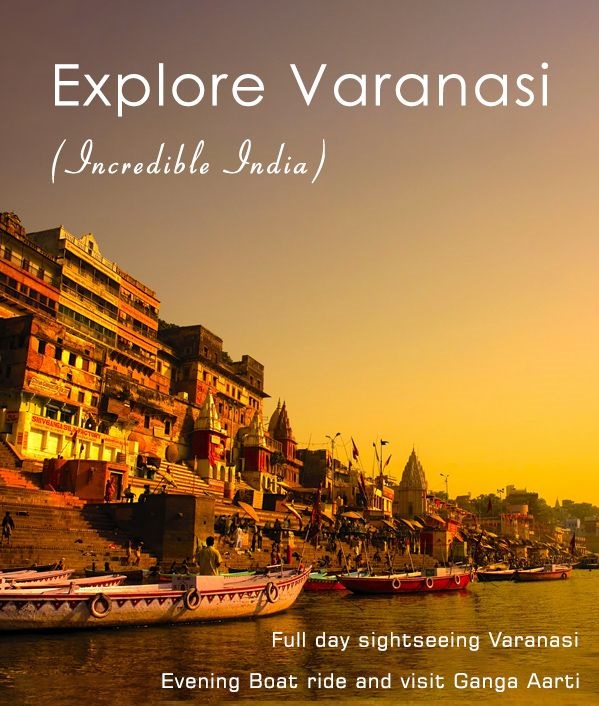
Varanasi, also known as Banaras or Kashi, is one of the oldest continuously inhabited cities in the world. Located on the banks of the sacred River Ganges in the northern Indian state of Uttar Pradesh, Varanasi is a city that pulsates with the rhythms of life and death. It is renowned for its spiritual significance, vibrant culture, and historical heritage. The city is often referred to as the “Spiritual Capital of India” due to its profound religious influence and is a major pilgrimage destination for Hindus, Buddhists, and Jains.
Historical and cultural significance:
Varanasi holds a unique place in the history and culture of India. The city’s history dates back over 3,000 years and is deeply intertwined with the rise of Hinduism. It is believed to be the abode of Lord Shiva, one of the principal deities in Hinduism. Varanasi is home to the Kashi Vishwanath Temple, dedicated to Shiva, which attracts millions of pilgrims annually.
The city is also significant in the history of Buddhism. It was near Varanasi, in Sarnath, that Gautama Buddha gave his first sermon after attaining enlightenment, making it a pivotal site in Buddhist history. Jainism, too, finds its roots in Varanasi as the birthplace of Parsvanatha, the 23rd Tirthankara.
Culturally, Varanasi has been a center of learning, philosophy, music, and crafts. The Banaras Hindu University, one of the largest residential universities in Asia, continues this tradition of learning. The city has also produced many renowned musicians, poets, and scholars, contributing to its rich cultural tapestry.
Unique aspects of Varanasi:
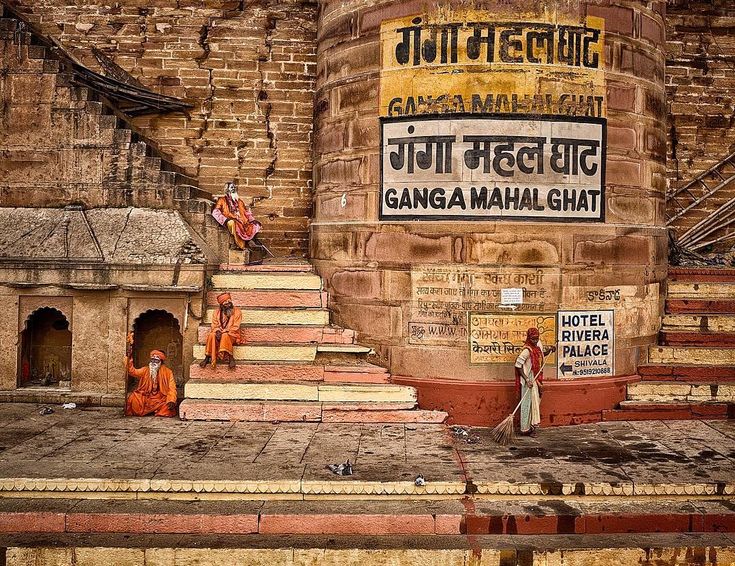
- Ghats and the Ganges:
- The ghats (steps leading down to the river) of Varanasi are perhaps its most iconic feature. There are around 88 ghats, each with its own significance. The Dashashwamedh Ghat, Manikarnika Ghat, and Assi Ghat are among the most famous. These ghats are used for various purposes, including rituals, bathing, and cremation.
- Spiritual Atmosphere:
- The city’s atmosphere is imbued with spirituality and devotion. The Ganga Aarti, a daily ritual performed at the ghats, is a mesmerizing spectacle of lights, chants, and incense, attracting both pilgrims and tourists.
- Rich Traditions:
- Varanasi is known for its classical music and dance, with institutions like the Benares Gharana influencing the Hindustani classical music tradition. The city is also famous for its Banarasi silk sarees, which are highly prized for their intricate designs and craftsmanship.
- Sarnath:
- Just a short distance from Varanasi, Sarnath is where Buddha delivered his first sermon. The site includes the Dhamek Stupa, Ashoka Pillar, and several ancient monasteries, making it an important pilgrimage site for Buddhists.
- Festivals:
- The city hosts numerous festivals throughout the year, including Diwali, Holi, and the Dev Deepawali, which sees the ghats illuminated with thousands of earthen lamps.
In summary, Varanasi is a city that offers a unique blend of the sacred and the secular, where ancient traditions continue to thrive in a bustling, modern context. Its historical and cultural significance, coupled with its vibrant and spiritual atmosphere, makes it a must-visit destination for travelers seeking a deep and enriching experience.
Getting There
| Travel From | Mode | Details | Booking Options |
| Within India: | Air | Lal Bahadur Shastri Airport, flights from major Indian cities | Airline websites |
| Train | Varanasi Junction, well-connected to major cities | IRCTC website, Cleartrip, Paytm | |
| Road | Access via NH19 from Kolkata/Delhi, NH31 from south/west | RedBus, Paytm, direct operator sites | |
| International | Air | Fly to major Indian cities, then take a domestic flight to Varanasi | Expedia, Google Flights, airline websites |
| Train | After reaching India, scenic train ride to Varanasi | IRCTC, travel agents | |
| Road | Car hire from major cities, long drive to Varanasi | Car rental agencies, travel agents |
Additional Travel Tips:
- Planning: Book early, especially during festivals.
- Visa and Transit: Check visa requirements and ensure transit visa compliance if necessary.
- Local Connectivity: Obtain a local SIM card upon arrival for ease of communication.
- Health Precautions: Opt for travel insurance and carry essential medications.
Local Transportation
Varanasi’s local transportation options provide diverse ways to explore the city’s vibrant streets and serene riverfront. Here’s a detailed look at what you can expect:
| Mode of Transport | Description | Tips and Recommendations |
|---|---|---|
| Auto-rickshaws and Cycle-rickshaws | These are the most common and economical ways to navigate through the narrow lanes of Varanasi. Cycle-rickshaws are ideal for shorter distances and more immersive experiences of the bustling bazaars. | Agree on the fare before starting your journey to avoid any disputes. Be prepared for a bumpy ride in some areas. |
| Taxis and App-based Cabs | Taxis are available but not as prevalent as auto-rickshaws. App-based cabs such as Ola and Uber offer another convenient option for longer distances within the city. | Book via respective mobile apps for a hassle-free experience. Ideal for direct trips to/from the airport or railway station. |
| Boat Rides on the Ganges | A quintessential Varanasi experience, boat rides offer a unique perspective of the ghats and the rituals performed at the river. Sunrise and sunset rides are particularly popular. | Hire boats from any major ghat. Opt for a guided tour to enhance the experience with historical and cultural insights. |
| Bicycle and Scooter Rentals | Renting a bicycle or scooter can be an adventurous way to explore Varanasi independently. Many shops around the city offer rentals by the hour or day. | Check the vehicle’s condition and ensure you have a map or GPS, as navigating the city’s lanes can be challenging. |
Additional Considerations:
- Traffic and Roads: Varanasi’s roads are often congested and can be challenging for first-time visitors. Exercise caution, especially on two-wheelers.
- Cultural Sensitivity: When traveling near religious sites and during ceremonies, it’s respectful to keep noise to a minimum and follow local customs.
- Safety: Always wear helmets when riding scooters or bikes, and keep your belongings secure to prevent theft, especially in crowded areas.
This overview provides practical information to help tourists navigate Varanasi effectively, allowing for a smoother and more enjoyable experience of the city’s rich cultural tapestry.
Best Time to Visit
Visiting Varanasi at the right time of the year can enhance your experience significantly. The city’s climate and various cultural events play a crucial role in determining the best time to visit. Here’s a detailed seasonal overview:
| Season | Time Period | Climate | Recommendations |
|---|---|---|---|
| Peak Season | November to February | Cool and pleasant | Ideal for sightseeing and attending various cultural and religious festivals like Diwali and Maha Shivaratri. The weather is comfortable for exploring the city, and the river is often enveloped in a mystical fog in the early mornings. |
| Shoulder Season | October and March | Moderately warm | Good for visitors who wish to avoid the peak season crowds but still enjoy mild weather. Perfect for boat rides and evening ghats visits without the extreme cold of winter nights. |
| Off-Season | April to September | Hot and humid, with monsoon rains | Suited for budget travelers as accommodations and travel may be cheaper. Experience the city in its lush monsoon beauty, though be prepared for sporadic showers and hot weather. |
Climate Considerations:
- Temperature: The temperature in Varanasi can vary widely throughout the year. In winter (peak season), it ranges from 5°C to 20°C, making it chilly especially in the mornings and late evenings. Summers (off-season) see temperatures soaring up to 45°C, which can be quite oppressive.
- Monsoon: The monsoon season, typically from late June to September, brings heavy rains which rejuvenate the Ganges and the surrounding landscapes but might disrupt daily travel plans.
Travel Tips for Varanasi:
- Dress Appropriately: Depending on the season, ensure you carry suitable clothing—warm layers for winter and light, breathable fabrics for summer.
- Stay Hydrated: The summer heat in Varanasi can be intense. Always carry a water bottle, and remember to stay hydrated.
- Check Local Calendars: Align your visit with local festivals for a more enriching experience but book well in advance as the city gets crowded during major celebrations.
Choosing the right time to visit Varanasi not only ensures a comfortable journey but also lets you engage deeply with the city’s rich spiritual and cultural heritage.
Where to Stay
Varanasi offers a wide range of accommodation options catering to different budgets and preferences. Here’s a breakdown to help you decide where to stay during your visit:
| Category | Description | Recommendations |
|---|---|---|
| Luxury Hotels | These hotels provide premium services, comfort, and exclusive facilities such as spas, fine dining, and stunning views of the Ganges. Ideal for those seeking comfort and luxury. | Brijrama Palace: One of the oldest landmarks of the city located on the ghats. Includes cultural performances. Taj Nadesar Palace: Set amidst mango orchards, jasmine fields, and marigolds, offers a tranquil luxury retreat. |
| Mid-Range Accommodations | Comfortable accommodations offering good value for money. These hotels and guesthouses provide clean and pleasant environments with essential amenities. | Guleria Kothi: At the ghats, offers a blend of traditional and modern amenities. Hotel Surya, Kaiser Palace: A converted royal palace with a history dating back to the 1800s. |
| Budget and Backpacker Hostels | Economical options for solo travelers, backpackers, or groups looking for basic accommodations. Common areas and shared facilities promote a social atmosphere. | Zostel Varanasi: Popular among backpackers, located close to major attractions, offers both dorms and private rooms. Stops Hostel: Known for its vibrant environment and traveler-friendly services. |
| Guesthouses and Homestays | For a more personal touch, these accommodations are often family-run and provide insights into the local lifestyle. More intimate settings and home-cooked meals are common. | Suraj Guest House: Offers a homely environment and panoramic views of the river. Ganpati Guest House: Well-loved for its hospitable staff and excellent location near the ghats. |
Tips for Choosing Accommodation:
- Location: Consider staying near the ghats or the old city to be close to Varanasi’s main cultural sites. However, if you prefer quieter surroundings, look for options slightly away from the center.
- Book in Advance: Especially during the peak travel season and around major festivals, Varanasi can get very crowded. Booking your accommodation well in advance is advisable.
- Check Reviews: Before finalizing your stay, read recent reviews from other travelers to ensure that the accommodation meets your expectations.
Best Places to Visit

Must-Visit Attractions
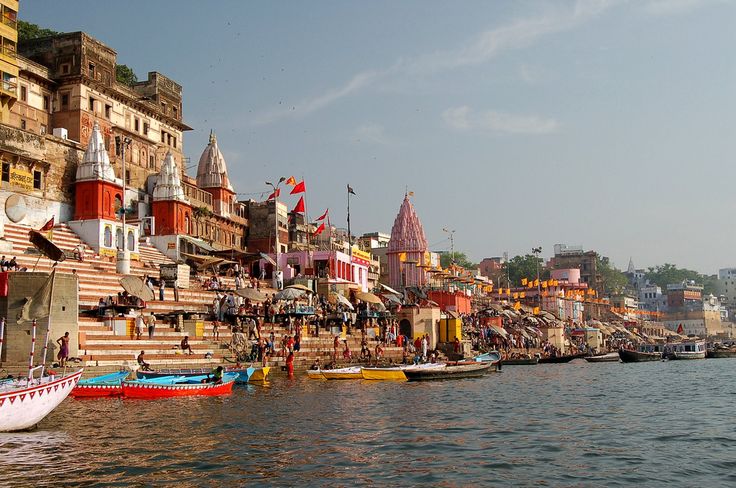
Ghats:
varanasi is renowned for its spiritual ambiance, particularly along its numerous ghats, the riverfront steps leading to the banks of the Ganges. Here’s a guide to some of the must-visit ghats in Varanasi:
Dashashwamedh Ghat:
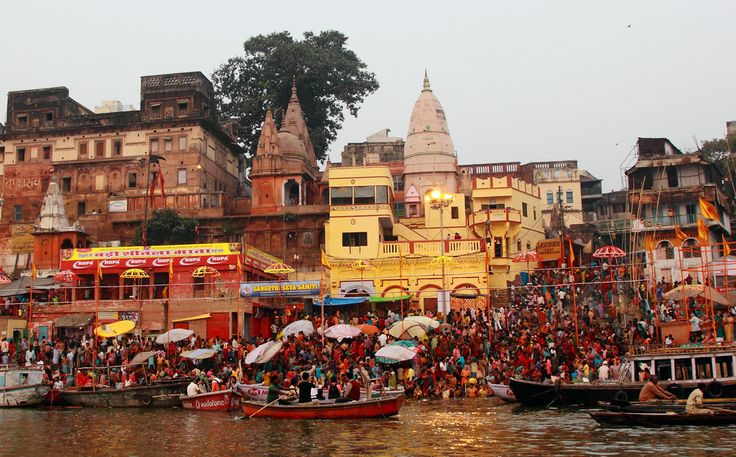
- Description: Considered the most spectacular ghat, this is where the famous Ganga Aarti takes place every evening. It’s one of the oldest and holiest ghats, bustling with activity.
- Activities: Attend the Ganga Aarti; boat rides during sunrise or sunset.
- Approximate Cost: Free to visit; Boat rides vary from ₹150-₹500 per person depending on the boat type and negotiation.
Assi Ghat:
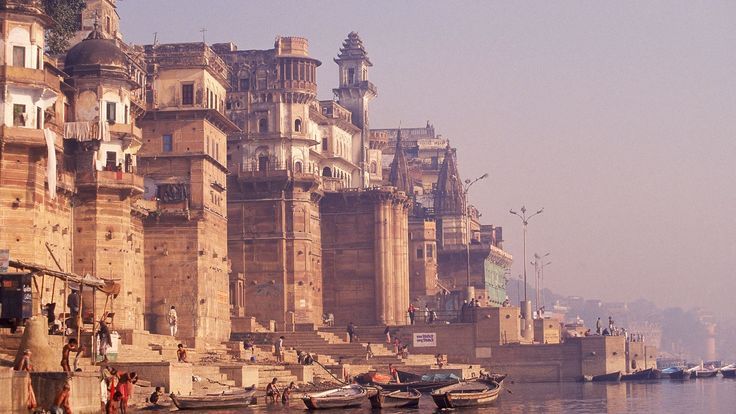
- Description: Situated at the confluence of the Assi and the Ganges River, this ghat has significant religious importance and is popular for morning rituals and yoga sessions.
- Activities: Participate in morning rituals; enjoy cultural performances in the evening; yoga sessions.
- Approximate Cost: Free to visit; Yoga sessions might cost around ₹200-₹500 per session.
Manikarnika Ghat:
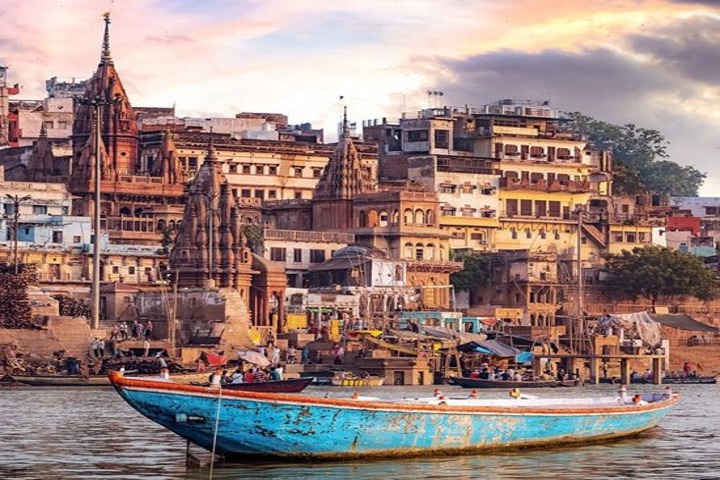
- Description: This is the main burning ghat and one of the most auspicious places for Hindus to be cremated. The fires here burn 24 hours a day, symbolizing the life and death cycle.
- Activities: Witness the cremation rituals (from a respectful distance); learn about the rituals from a local guide.
- Approximate Cost: Free to visit; Guide fees vary typically around ₹200-₹500
Temples:
Varanasi is not only known for its ghats but also for its ancient and sacred temples. Here’s a guide to some of the must-visit temples in the city:
Kashi Vishwanath Temple:
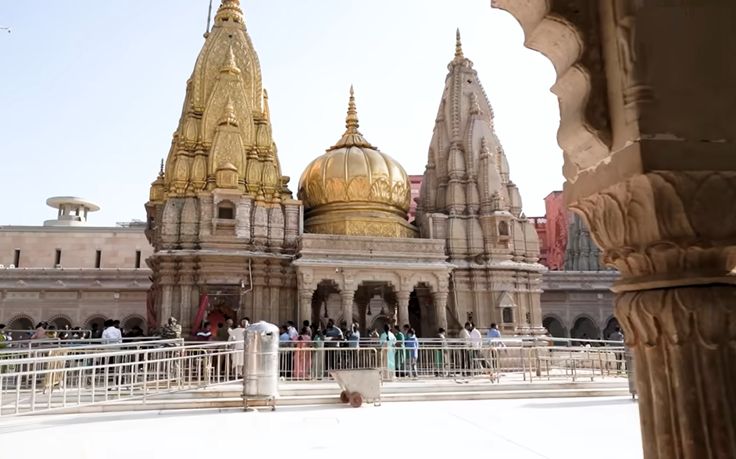
- Description: One of the most famous Hindu temples dedicated to Lord Shiva, the Kashi Vishwanath Temple holds immense spiritual significance. It is one of the twelve Jyotirlingas, the holiest of Shiva temples.
- Location: Located in the Vishwanath Gali of Varanasi.
- Visiting Tips: The temple is heavily secured, so carry minimal belongings. Photography inside the temple premises is prohibited.
Sankat Mochan Hanuman Temple:
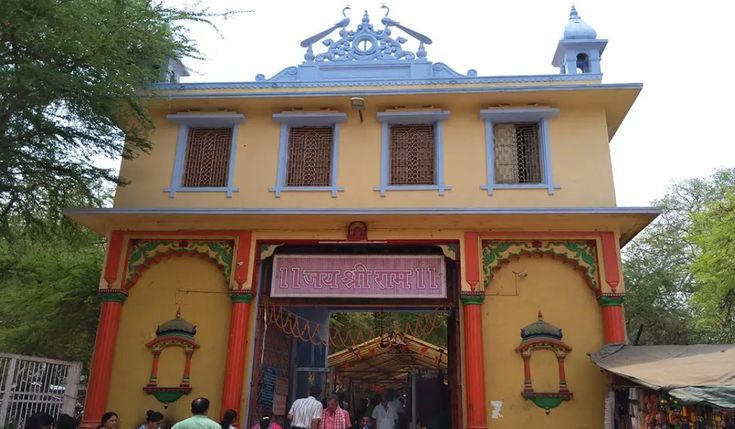
- Description: Dedicated to Lord Hanuman, this temple is a center of unique devotion, famously known to relieve devotees of their troubles (“Sankat”).
- Location: Near the Banaras Hindu University.
- Visiting Tips: Visit during early morning or evening Aarti for a spiritual experience. The temple is also known for its laddu prasad, which is widely revered.
Durga Temple:
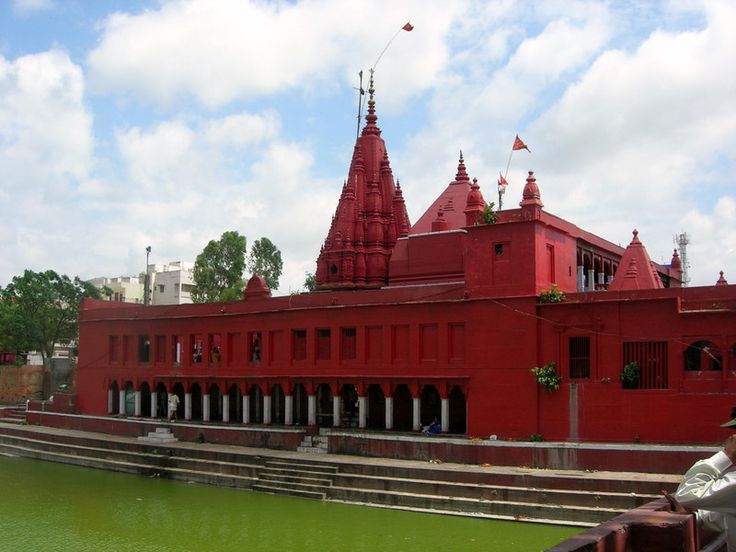
- Description: Often called the Monkey Temple due to the large number of monkeys found in the area, this 18th-century temple is dedicated to Goddess Durga and was built in a Nagara architectural style.
- Location: Durga Kund, Varanasi.
- Visiting Tips: Be cautious of the monkeys around the temple, and it’s advised to secure your belongings and avoid feeding the animals.
Historic Sites:
Varanasi is steeped in history and culture, with numerous historic sites that offer a glimpse into its rich past. Here are some must-visit historic sites in Varanasi:
Ramnagar Fort:
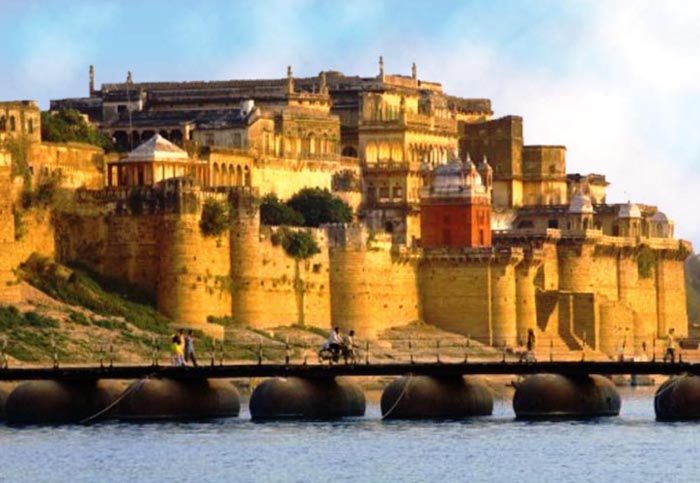
- Description: This 18th-century fortification, built by Kashi Naresh Raja Balwant Singh, is situated on the eastern bank of the Ganges. The fort is an excellent example of Mughal architecture with influences of Indian style.
- Location: Ramnagar, Varanasi.
- Attractions: The fort houses the Vyas Temple, a museum displaying vintage cars, royal costumes, medieval weapons, and a rare collection of manuscripts.
- Visiting Tips: The best time to visit is during the Ramnagar Ramlila festival, a month-long event that reenacts the story of Ramayana with great fervor.
Bharat Mata Temple:
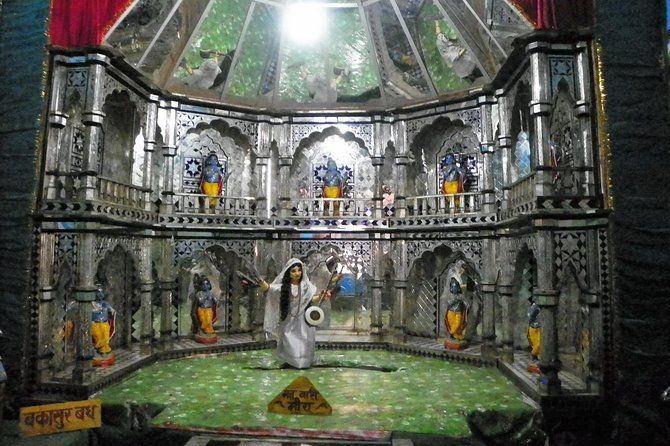
- Description: Unlike typical temples, the Bharat Mata Temple is dedicated to Mother India and features a unique marble relief map of India, depicting the country’s geographical layout and sacred rivers.
- Location: Near Mahatma Gandhi Kashi Vidyapith campus, Varanasi.
- Attractions: The temple was inaugurated by Mahatma Gandhi and serves as a symbol of national unity and pride.
- Visiting Tips: Visit during weekdays to avoid crowds. It’s a great spot for those interested in history, geography, and Indian nationalism.
Cultural Sites:
Varanasi is a hub of cultural heritage and learning, home to several significant cultural sites. Here are some key places that every visitor should explore:
Sarnath:
Description: Sarnath is one of the most important Buddhist pilgrimage sites, where Gautama Buddha delivered his first sermon after attaining enlightenment. It is also known as the Deer Park.Location: About 10 kilometers northeast of Varanasi.Attractions:
- Dhamek Stupa: A massive stupa marking the spot where Buddha gave his first sermon.
- Chaukhandi Stupa: An important Buddhist monument, marking the place where Buddha met his first disciples.
- Sarnath Museum: Houses an extensive collection of Buddhist artifacts and sculptures, including the famous Ashoka Pillar with the Lion Capital, which is the national emblem of India.
- Mulagandha Kuti Vihara: A modern Buddhist temple with beautiful frescoes depicting the life of Buddha.
- Banaras Hindu University
Visiting Tips: Allocate at least half a day to explore Sarnath thoroughly. Hire a guide to gain deeper insights into the significance of each monument. Wear comfortable walking shoes as you’ll be moving between various sites.
Banaras Hindu University (BHU):
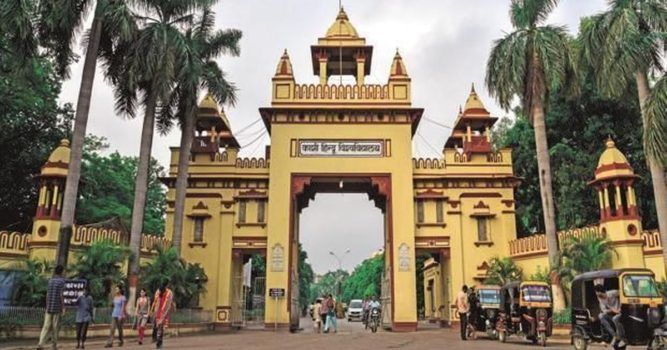
- Description: Established in 1916 by Pandit Madan Mohan Malaviya, BHU is one of the largest residential universities in Asia. It is a major educational and cultural center.
- Location: Situated in the southern part of Varanasi.
Attractions:
- Bharat Kala Bhavan Museum: Houses a rich collection of paintings, sculptures, and textiles representing Indian art and history.
- New Vishwanath Temple: A grand temple located within the campus, dedicated to Lord Shiva, designed to be a replica of the original Kashi Vishwanath Temple.
- Sundar Lal Library: One of the largest libraries in India with a vast collection of books and manuscripts.
Visiting Tips: The campus is vast, so consider using a cycle rickshaw or walking to explore. Visit during the academic year to experience the vibrant student life and cultural activities. The museum and temple have specific visiting hours, so plan accordingly.
Things to Do
Varanasi offers a plethora of activities that provide a deep and immersive experience of the city’s spiritual and cultural essence. Here are some must-do activities:
Attend the Ganga Aarti ceremony
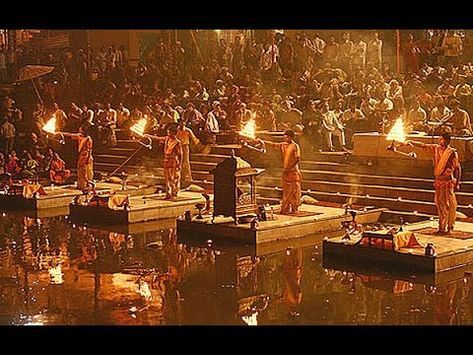
- Description: The Ganga Aarti is a daily ritual performed at Dashashwamedh Ghat in the evening. It involves chanting, lamps, and incense offerings to the River Ganges.
- Tips: Arrive early to get a good spot. You can watch the ceremony from the ghat or hire a boat for a unique view from the river. Photography is allowed but be respectful of the ceremony.
Take a Sunrise or Sunset Boat Ride on the Ganges:
- Description: A boat ride on the Ganges offers a unique perspective of Varanasi’s ghats and temples, especially beautiful during sunrise and sunset.
- Tips: Negotiate the price before boarding. Sunrise rides typically start early around 5:30 AM, and sunset rides around 5:00 PM. Dress warmly if visiting during cooler months.
Explore the narrow lanes of the old city
- Description: The old city of Varanasi is a maze of narrow lanes filled with small shops, temples, and local life.
- Tips: Wear comfortable shoes and be prepared for a lot of walking. It’s easy to get lost, so consider hiring a local guide. Keep your belongings secure as the lanes can be crowded.
Participate in a yoga session or meditation class
- Description: Varanasi, with its spiritual ambiance, is an ideal place to practice yoga and meditation.
- Tips: Many ashrams and yoga centers offer drop-in classes. Popular places include the International Yoga Community and Kashi Yoga Sangha. Check schedules in advance and bring your own mat if you prefer.
Visit local markets and bazaars
- Description: Varanasi’s markets are vibrant and filled with everything from silk sarees to brassware and local snacks.
Popular Markets:
- Vishwanath Gali: Known for its religious items, silk fabrics, and local sweets.
- Thatheri Bazaar: Famous for brassware and traditional household items.
- Chowk and Godowlia: Ideal for shopping and experiencing the local hustle and bustle.
Tips: Bargaining is common, so don’t hesitate to negotiate prices. Keep an eye on your belongings and enjoy local street food but choose clean and busy stalls.
8. Local Cuisine
Varanasi, also known as Benaras, is a city in the Indian state of Uttar Pradesh. It is one of the oldest continuously inhabited cities in the world and is considered one of the holiest cities in Hinduism. Varanasi is also known for its vibrant culture, including its food.
Must-try dishes:
- Kachori: Kachori is a deep-fried savory pastry filled with a spicy mixture of lentils, potatoes, and spices. It is a popular breakfast dish in Varanasi and is often served with aloo sabzi, a curry made from potatoes and spices.
- Banarasi Paan: Banarasi paan is a type of betel leaf preparation that is popular in Varanasi. It is made with betel leaf, areca nut, catechu, slaked lime, and various spices. Banarasi paan is said to have digestive and aphrodisiac properties.
- Lassi: Lassi is a refreshing drink made from yogurt, water, and spices. It is a popular drink in India and is often served with meals.
Recommended restaurants and street food spots
- Kashi Vishwanath Temple: The Kashi Vishwanath Temple is one of the holiest Hindu temples in the world. It is also home to a number of popular street food stalls.
- Assi Ghat: Assi Ghat is one of the most popular ghats in Varanasi. It is a great place to try street food, as well as to watch the world go by.
- Chowk: Chowk is the main market area in Varanasi. It is a great place to find authentic Banarasi food at affordable prices.
- Shri Kashi Annapurna Bhojanalaya: Shri Kashi Annapurna Bhojanalaya is a charity-run restaurant that serves free vegetarian food to pilgrims. It is a great place to experience the local culture and to try some traditional Banarasi dishes.
These are just a few of the many great places to eat in Varanasi. With its rich culinary heritage, Varanasi is sure to satisfy any foodie.
Additional tips:
- When trying street food in Varanasi, be sure to bargain with the vendors.
- Be sure to try the local lassi, which is made with yogurt, water, and spices.
- If you are feeling adventurous, try some of the more exotic dishes, such as brains or tripe.
- Be sure to drink plenty of water, as the weather in Varanasi can be very hot.
- Varanasi is a safe city to travel to, but it is always a good idea to be aware of your surroundings and to take precautions against petty theft.
9. Shopping
Best places to shop: Thatheri Bazaar, Vishwanath Gali
Varanasi offers a delightful shopping experience, especially if you’re looking for local crafts and souvenirs. Here are some of the best places to shop and what you can find there:
- Thatheri Bazaar: This bustling market is a treasure trove of traditional handicrafts and souvenirs.pen_spark
Local crafts and souvenirs: Silk sarees, wooden toys, brassware
- Silk sarees: Varanasi is world-famous for its exquisite silk sarees, handwoven with intricate designs and rich colors.
- Wooden toys: You’ll find a charming collection of wooden toys crafted by skilled artisans. These toys are not just for children, but also make beautiful decorative pieces.pen_spark
- Brassware: Thatheri Bazaar is known for its brassware, including decorative items, utensils, and idols of Hindu deities.
- Vishwanath Gali: Located near the Kashi Vishwanath Temple, this narrow lane is a haven for metal handicrafts.
10. Cultural Insights
Understanding local customs and etiquette
Varanasi, a city steeped in tradition, offers a vibrant cultural experience. Here’s a glimpse into local customs, etiquette, religious practices, and festivals:
Local Customs and Etiquette:
- Respectful attire: When visiting temples or religious sites, dress modestly. Opt for clothing that covers shoulders and knees.
- Greetings: Greet holy men and women with a respectful “Namaste” (folded hands and a slight bow).
- Shoes off: Always remove your shoes before entering temples or homes.
- Photography: Ask permission before taking photos of people, especially during religious ceremonies.
- Public displays of affection: Public displays of affection are generally not encouraged.
Religious practices:
- Aarti: Witness the daily aarti, a mesmerizing fire puja (offering) performed on the ghats (river steps) along the Ganges.
- Holika Dahan: Experience the vibrant festival of Holika Dahan, also known as the festival of colors, which signifies the triumph of good over evil.
- Ganga Aarti: Partake in the evening Ganga Aarti, a spectacular ceremony with hundreds of lamps offered to the Ganges, creating a mesmerizing sight.
Festival Celebrations:
- Diwali: Diwali, the festival of lights, is a joyous celebration that illuminates the city with rows of diyas (oil lamps).
- Maha Shivaratri: During Maha Shivaratri, a major Hindu festival honoring Lord Shiva, witness grand processions and special pujas at temples.
- Sarnath Sarnath Festival: Held near Varanasi in Sarnath, this festival commemorates Buddha’s first sermon after attaining enlightenment.
11. Itineraries
itineraries for 1-day
| Time of Day | Activity |
| Morning: | |
| 6:00 AM | Assi Ghat: Start your day with a serene boat ride during sunrise at Assi Ghat. |
| 8:00 AM | Kashi Vishwanath Temple: Visit the most famous temple dedicated to Lord Shiva. |
| 9:00 AM | Breakfast: Enjoy a traditional breakfast at a local eatery, such as Kachori Sabzi and Jalebi. |
| Mid-Morning | |
| 10:00 AM | Banaras Hindu University (BHU): Explore the beautiful campus and visit the Bharat Kala Bhavan Museum. |
| Afternoon | |
| 12:30 PM | Lunch: Have a traditional Banarasi lunch at a recommended restaurant. |
| 2:00 PM | Sarnath: Visit this historical site where Buddha gave his first sermon. Explore the Dhamek Stupa, Chaukhandi Stupa, and Sarnath Museum. |
| Evening | |
| 6:30 PM | Dashashwamedh Ghat: Experience the Ganga Aarti, a mesmerizing ritual on the banks of the Ganges. |
| 8:00 PM | Dinner: Enjoy a leisurely dinner at a riverside restaurant. |
3-Day Itinerary in Varanasi
| Day | Morning | Afternoon | Evening |
| Day 1 | Same as 1-Day Itinerary | Same as 1-Day Itinerary | Same as 1-Day Itinerary |
| Day 2 | Visit Ramnagar Fort | Explore the weavers’ village for Banarasi silk shopping | Evening walk along the Ghats and explore local eateries |
| Day 3 | Boat Ride to Chunar Fort | Visit Chunar Fort and nearby attractions | Relax at Assi Ghat, possibly attend a cultural or music event |
and week-long stays
| Day | Morning | Afternoon | Evening |
| Day 1-3 | Follow the 3-Day Itinerary | Follow the 3-Day Itinerary | Follow the 3-Day Itinerary |
| Day 4 | Day trip to Allahabad | Explore Allahabad Fort, Triveni Sangam | Return to Varanasi, light dinner |
| Day 5 | Explore local markets | Lunch and visit to Bharat Mata Mandir | Cooking class on local cuisine |
| Day 6 | Visit Tulsi Manas Temple and Durga Temple | Free time for additional shopping or exploration | Attend a traditional dance performance at a local theater |
| Day 7 | Leisurely walk through the old city | Visit any missed attractions or repeat favorite experiences | Farewell dinner at a gourmet restaurant |
12. Travel Tips
Health and safety tips
- Vaccinations and Medications: Check if you need any specific vaccinations before traveling. Always carry a basic travel health kit with medications for common ailments such as headaches, diarrhea, and allergies.
- Travel Insurance: Invest in comprehensive travel insurance that covers medical emergencies, trip cancellations, and lost luggage.
- Local Emergency Numbers: Know the local emergency numbers for police, medical services, and fire services in the destination.
- Food and Water Safety: Avoid drinking tap water unless it’s declared safe. Be cautious with street food; opt for busy stalls where high turnover ensures food freshness.
- Personal Safety: Be aware of your surroundings, especially in crowded places. Avoid carrying large sums of cash and keep valuables in a safe place.
Currency and budgeting
- Local Currency: Familiarize yourself with the local currency. Understand the approximate conversion rates before you go.
- Budgeting: Create a daily budget to cover food, accommodations, transport, and activities. Consider additional funds for souvenirs and unexpected expenses.
- Credit Cards and Cash: Carry a mix of cash and cards. Inform your bank of your travel plans to avoid any fraud alerts or blocks on your cards.
- Money Exchange: Exchange some currency before you leave home to avoid high airport rates. Use reputable banks or exchange bureaus in the destination.
Language and communication tips
- Basic Phrases: Learn basic phrases in the local language, such as greetings, directions, and common questions. This can greatly enhance your interaction with locals.
- Translation Tools: Download a translation app on your smartphone, which can be incredibly useful for reading signs and menus or communicating with locals.
- Local SIM Card: Purchase a local SIM card for access to data and local calls. This is usually cheaper than using international roaming.
Packing essentials
- Clothing: Pack according to the weather but always bring a versatile jacket or a raincoat. Comfortable walking shoes are a must.
- Essential Documents: Carry your passport, visa (if required), travel insurance details, and any medical prescriptions. Keep digital copies of these documents in your email or cloud storage.
- Electronics: Pack chargers, adapters suitable for the destination, and a power bank for charging devices on the go.
- Sustainable Items: Bring reusable water bottles, shopping bags, and utensils. This helps in reducing your environmental footprint.
13. Sustainable Tourism
How to travel responsibly in Varanasi
- Respect Cultural Norms: Varanasi is a sacred city with deep religious significance. Dress modestly, especially when visiting temples and during ceremonies. Be mindful of local customs and rituals, and always ask for permission before taking photographs of religious events or people.
- Eco-Friendly Transportation: Opt for walking or cycling when exploring the city to reduce carbon emissions. For longer distances, use public transportation or shared auto-rickshaws instead of hiring private vehicles.
- Sustainable Accommodation: Choose to stay in eco-friendly hotels or guesthouses that use sustainable practices like solar power, water conservation methods, and waste recycling.
Supporting local businesses
- Shop Local: Buy handicrafts, textiles, and other goods directly from local artisans and small shops rather than from big tourist stores. This ensures your money supports the local economy and helps preserve traditional crafts.
- Eat Local: Dine at local eateries and street food vendors that source their ingredients locally. This not only gives you a taste of authentic Varanasi cuisine but also supports local farmers and small business owners.
- Choose Local Guides: Hire local guides for authentic insights into the city’s history and culture. This not only provides you with a richer experience but also helps the local community benefit directly from tourism.
Environmental conservation efforts
- Reduce Plastic Use: Avoid single-use plastics by carrying a reusable water bottle, shopping bags, and food containers. Many temples and religious sites in Varanasi are trying to reduce plastic waste, so supporting these efforts is crucial.
- Participate in Clean-Ups: Engage in local initiatives aimed at cleaning up the Ganges and the ghats. Participating in such activities can help raise awareness and contribute to the preservation of these important sites.
- Support Conservation Projects: Donate to or volunteer with organizations working on environmental conservation in Varanasi. These could include projects aimed at cleaning the Ganges, planting trees, or educating locals and tourists about environmental issues.
14. Emergency Contacts
Local police and medical services
Local Police:
- Emergency Number: Dial 100 for police assistance, which is the nationwide emergency number in India.
- Local Police Station: It’s helpful to know the contact details and location of the nearest police station from where you’ll be staying. Varanasi has several police stations; details can usually be obtained from your accommodation provider.
Medical Services:
- Emergency Medical Number: Dial 108 for ambulance services across Varanasi.
- Hospitals:
- Sir Sunderlal Hospital (BHU Hospital): Located within the Banaras Hindu University campus, it’s one of the largest and well-equipped hospitals in Varanasi.
- Heritage Hospitals Limited: Located near Lanka, this is a private hospital offering a range of medical services.
- Pharmacies: Pharmacies are widely available. Large hospitals have 24-hour pharmacies, which are useful in emergencies.
Tourist Information Centers
- Varanasi Tourist Office:
- Location: Near Godaulia, you can find the UP Tourism Office which offers information about local attractions, maps, and other tourist services.
- Contact: It’s useful to contact them for any latest updates on travel advisories or events in the city.
- Government of India Tourist Office:
- Location: Typically located in main areas or near major tourist sites, these offices provide comprehensive travel guides, brochures, and assistance with accommodations and tours.
- Online Resources:
- Official Tourism Websites: Websites like the Uttar Pradesh Tourism website (uptourism.gov.in) can offer valuable insights and up-to-date information about Varanasi.
- Apps: Consider downloading travel apps that provide information about local attractions, translate languages, or give detailed maps.
15. FAQs
Answers to common questions tourists might have about visiting Varanasi
Visitors to Varanasi often have several questions about the city, its customs, and logistics. Here are answers to some frequently asked questions that might help tourists plan their trip better:
1. What is the best time to visit Varanasi?
Answer: The best time to visit Varanasi is during the cooler months from November to February when the weather is pleasant. March to June can be extremely hot, and the monsoon season from July to October might lead to heavy rains and flooding of the riverbanks.
2. How can I get to Varanasi?
Answer: Varanasi is well-connected by air, rail, and road. Lal Bahadur Shastri International Airport serves both domestic and international flights. Varanasi Junction (commonly known as Varanasi Cantt Station) is a major railway hub. Buses also connect Varanasi with major cities in the region.
3. What are the must-see attractions in Varanasi?
Answer: Key attractions include the Ghats along the River Ganges, especially Dashashwamedh and Assi Ghats; the evening Ganga Aarti ceremony; Kashi Vishwanath Temple; Sarnath, where Buddha gave his first sermon; and the Ramnagar Fort.
4. Is Varanasi safe for tourists?
Answer: Varanasi is generally safe for tourists but, like any busy tourist destination, it is advisable to take precautions against petty theft, especially in crowded areas. Women travelers should dress conservatively and avoid isolated areas at night.
5. What should I wear when visiting temples and religious sites in Varanasi?
Answer: Dress modestly when visiting religious sites. Long pants and shirts that cover the shoulders are advisable. Some temples may require visitors to remove their shoes or wear a head covering, so it’s useful to be prepared for that.
6. What local foods should I try in Varanasi?
Answer: Varanasi is famous for its street food, including chaat, kachori sabzi, and sweets like jalebi and rabri. Don’t miss trying the lassi served in clay cups for an authentic local experience.
7. Can I take photographs at the Ghats or temples?
Answer: Photography at the Ghats is usually permissible, but always ask for permission before taking photos of people or specific ceremonies. Photography inside the main sanctum of temples is often prohibited, and signs will generally indicate this.
8. What are some tips for respecting local culture in Varanasi?
Answer: Showing respect involves dressing modestly, being quiet and reverent at religious sites, not intruding on ceremonies or people’s prayers, and not consuming alcohol or eating non-vegetarian food near religious sites.
9. How can I contribute to sustainable tourism in Varanasi?
Answer: Support local businesses by buying local crafts and eating at local restaurants, minimize plastic use, participate in local clean-up drives if possible, and respect the natural and cultural sites by not littering or defacing property.
10. What should I bring home as a souvenir from Varanasi?
Answer: Popular souvenirs include Banarasi silk saris or scarves, religious artifacts, local handicrafts, and sandalwood beads. Purchasing these from local artisans not only provides you with a unique memento but also supports the local economy.
These FAQs should help tourists feel more prepared and informed about their visit to Varanasi, ensuring a smoother and more respectful experience.
16. Conclusion
Final thoughts and tips to ensure a memorable visit
Concluding your journey in Varanasi with lasting memories hinges on embracing the city’s spiritual ambiance, rich history, and vibrant daily life. Here are some final thoughts and tips to help ensure your visit is both enriching and memorable:
Embrace the Cultural Depth
Varanasi is more than just a tourist destination; it’s a profound cultural and spiritual experience. Engage with the city by participating in the local rituals, attending the Ganga Aarti, and spending quiet moments by the Ghats to truly absorb the essence of this ancient city.
Respect Local Traditions
Show deep respect for the local customs and traditions. This includes dressing modestly, especially when visiting temples and participating in rituals. Understand the significance of the sites you visit to appreciate the context of your experiences fully.
Explore Beyond the Tourist Paths
While the well-trodden paths offer their own charm, exploring the less-visited parts of Varanasi can provide a deeper insight into local life. Wander through the old alleys, visit local markets, and try foods from vendors who don’t usually serve tourists.
Sustainable Practices
Contribute positively by engaging in sustainable tourism practices. Use eco-friendly transport options, support local artisans, avoid plastic, and respect the cleanliness and sanctity of the Ghats and the Ganges.
Health and Safety
Always prioritize your health and safety. Drink bottled or filtered water, eat freshly cooked food, and carry necessary medications. Keep emergency contacts handy and stay informed about local issues during your visit.
Engage with the Locals
The people of Varanasi are known for their warmth and hospitality. A conversation with a local can provide insights no guidebook can offer. Engage with shopkeepers, rickshaw drivers, and other locals to enrich your experience.
Keep Flexible Itineraries
Varanasi can be unpredictable. Religious festivals, political rallies, or even a regular day near the Ghats can change your travel plans. Keeping a flexible schedule allows you to adapt and enjoy the spontaneous moments that make Varanasi unique.
Reflect on Your Experience
Take time to reflect on your experiences each day. Varanasi offers countless moments of beauty, spirituality, and connection. Writing a journal or sharing stories with friends can deepen your appreciation and understanding of the experiences you’ve had.
By keeping these tips in mind, you can ensure that your visit to Varanasi is not only memorable but also respectful and insightful. Each visit to Varanasi is unique, and with the right approach, you can leave with a deeper understanding of this enchanting city.
